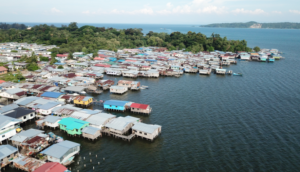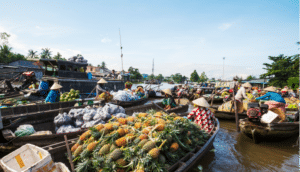Working collaboratively with farmers, companies, and governments in a defined geographical region is not only an effective way to accelerate sustainable land management and increase famer livelihoods, but they are also a very effective route to share risk, reduce costs, and create lasting change.
IDH’s goal is to protect and restore five million hectares of vulnerable landscapes by 2030 by encouraging pre-competitive collaboration to collective challenges like deforestation, decarbonising value chains and increasing farmer resilience.
Reaping the benefits of landscape initiatives requires long-term commitment and continuous learning. Here are 10 of our lessons from the last 10 years of IDH’s support for such approaches in Asia, Africa and Latin America:
1. The core currency is trust.
It takes time to build trust and alignment with stakeholders, achieved through engagement, listening, and small-scale concrete actions. Once you have trust, the sky is the limit, and you can expand from working collaboratively on one priority like regenerative agriculture to another like compliance with the EU deforestation regulation.
2. Addressing a shared problem creates win-win-win.
In South West Mau Forest, Kenya, multiple stakeholders were affected by the forest being degraded. Tea production was reducing, communities suffered as they needed the forest for grazing, and there was less water for hydro power and drinking. A landscape approach benefitted all with a reduction in deforestation, positive impact on water cycles, and improved small producer income by two to three-fold.
3. The greatest business value is risk reduction.
As well as being cheaper and higher impact to work pre-competitively on aligned priorities than to do it farm by farm, the standout business value is often the reduction in risk, with spillover social or environmental risks declining dramatically.
4. Collaboration reduces the cost of compliance.
Collaborating with the Vietnamese government, IDH helped establish the world’s first national action plan for deforestation-free sourcing areas in compliance with EUDR. Independent analysis of Central Highlands of Vietnam shows that the cost of achieving regenerative outcomes together at landscape level was up to fifteen times cheaper than when companies did it alone.
5. Private sector involvement is critical to reaching scale.
In Mato Grosso, Brazil, the Sustainable Production of Calves program led to the development of a protocol that offers technical solutions for traceability in indirect beef supply. In September 2022, three of the leading meatpackers in the country set ambitious traceability targets critical to reaching scale. So far, there are over 200,000 animals in a traceability system as a crucial step in reducing deforestation.
6. Positive results enable expansion to a greater area.
In Aceh, Indonesia, a landscape initiative was set up to improve forest monitoring, restore degraded forest, and strengthen smallholder farmer income. Deforestation monitoring tools were used to calculate the results of forest protection practices. The positive results at a district level provided evidence for the initiative to expand to the provincial level, protecting a much greater area of biodiverse forest.
7. Patience is needed to see the benefits.
Multi-stakeholder coalitions take a year or two to establish. After that, positive impacts accelerate, since alignment is the key to tackling issues that need coordinated action, like anti-deforestation measures. Years three to five generally show a good return on the initial investment, with some of the biggest positive impacts emerging after year five.
8. Landscapes are not an investable asset class.
Landscapes initiatives aim to improve sustainability, resilience, and inclusivity across a region, but they do not function as standalone financial assets. Financial institutions may hesitate to commit capital that is geographically constrained. While landscapes are not investable on their own, they can enhance the viability and impact of investments in real assets like farms, agribusinesses and forest projects.
9. Landscape models can influence supply chains.
Landscape initiatives can be used to test and build resilient models to meet tomorrow’s challenges. These models for brands, governments, and farmers can then be taken up by supply chains, and help transform practise across a company or a sector.
10. Exiting a lead role requires careful planning.
Transitioning out of a landscape initiative requires careful planning to ensure continued good governance. Stakeholders engaged in the initiative must have full ownership of it to take over the convening role. Establishing an independent legal or institutional structure can give an initiative a solid basis to continue in the future.
To find out more about existing landscape initiatives from IDH and many other organisations visit SourceUp, where you can search through 65 existing initiatives by commodity or country.
This article is part of the Business Fights Poverty Climate Series with Fundação Dom Cabral (FDC) taking place during COP30 Climate Summit in Belém, Brazil.








